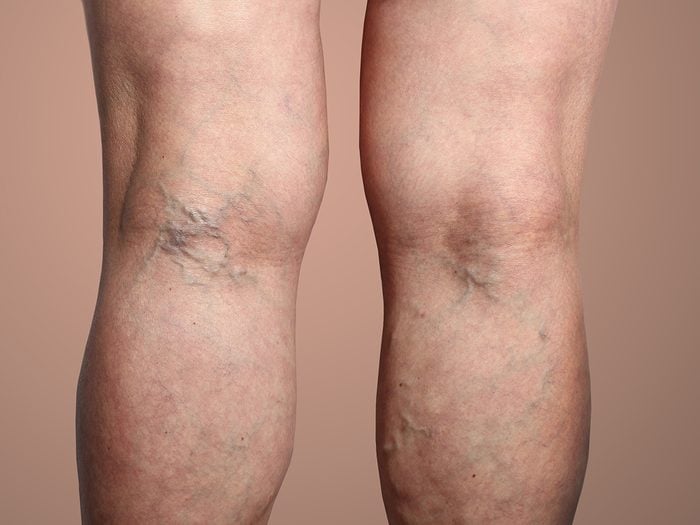A Doctor Answers All Your Questions About Varicose Veins

Here's when to worry about varicose veins, plus why they appear and how to treat them.
When it comes to caring for the health of our legs, a common concern is varicose veins. Often blue and bulging, these pesky veins can seemingly appear out of nowhere, obfuscating the once pristine canvas of our gams. But what are varicose veins? Why do they appear? Do they pose a health risk? And what can be done to get rid of them?
What are varicose veins?
Benjamin Barankin, a Toronto dermatologist, medical director and founder of Toronto Dermatology Centre, explains that varicose veins are superficial, enlarged, bulging and twisted veins that mainly develop in the legs. They’re dark purple or blue in colour and can cause aching, itching or discomfort. Their cousins, the spider veins, are a milder form, consisting of much smaller red or purple veins that are closer to the skin’s surface.
Why do they appear?
Varicose veins are due to weak or damaged valves in the veins that help to control blood flow towards the heart. When they’re not functioning properly, blood can pool in the veins, resulting in the veins stretching or twisting. There are several reasons why weak or damaged valves lead to the development of varicose veins, and unfortunately, they’re not necessarily something you can control. Barankin says the risk of weak or damaged valves is more common in women and potentially increased by pregnancy, menopause and possibly birth control pills. Age also plays a factor, thanks to wear and tear on the vein valves over time, as does being overweight, having a sedentary lifestyle, standing for long periods of time and having a family history of them.
When should you worry about them?
Varicose veins aren’t necessarily cause for medical concern. Barankin says that, for most patients, leg veins are nothing more than a cosmetic blight. However, “those with varicose veins are at higher risk of ulcers, bleeding—burst vein—and blood clots,” he says, recommending that anyone experiencing persistent leg pain and swelling seek medical help.
Is it possible to prevent them?
Before they appear, there are some ways to reduce the risk of developing varicose veins. Barankin says that the best prevention is exercise and maintaining a healthy weight. Other tips include raising your legs when sitting or lying down, eating a low-salt, high-fibre diet, changing your sitting or standing position regularly and avoiding wearing high-heeled shoes and hosiery. “There isn’t much data on alternative medicine, but some have reported improvement with horse chestnut, butcher’s broom, grapes—leaves, seed and fruit—and sweet clover,” he adds.
Other preventative measures may be a bit more pleasant, if not downright blissful. At the Park Hyatt Stillwater Spa in Toronto, the Detox + Revive Body Ritual focuses on circulation and fluid retention. “The ritual’s physical, mechanical body work, in conjunction with the products, aids the body in getting the accumulated blood and lymph fluid moving again throughout the body,” says spa director Kerry Werner.
What are the treatment options?
When you notice the early appearance of varicose veins, there are some strategies to help prevent them from getting worse. Barankin says compression stockings are the main therapy in early stages. “Wear compression stockings during the day, and apply a good moisturizer at night to reduce itching and dry or cracked skin,” he says. “Avoid salt to reduce leg swelling, wear more comfortable low-heeled shoes to work the calf muscle to pump more, and avoid tight clothing around your waist, legs and groin so as not to impede blood flow.”
What about removal options?
For those looking to have varicose veins professionally removed, there are a few different options. Sclerotherapy is a solution or foam, such as a sale-solution, that’s injected into the veins. It costs roughly $200 to $400 per session and may require three to six treatments every other month for results. Post sclerotherapy, compression socks for one to two weeks to fully optimize results, and contrary to what some people have heard, airplane travel is totally safe post-treatment.
Another option is vascular lasers, which can be used on spider veins or endovenous laser ablation for larger varicose veins. And finally, there’s surgical vein stripping—a minor surgery where one or more varicose veins are removed. This would likely be an in-and-out procedure with recovery at home for a few days following the operation, depending on how many veins are removed.
Ultimately, the decision of how to treat varicose veins is personal. Unless they are causing persistent pain or swelling, varicose veins are something that can be lived with.




